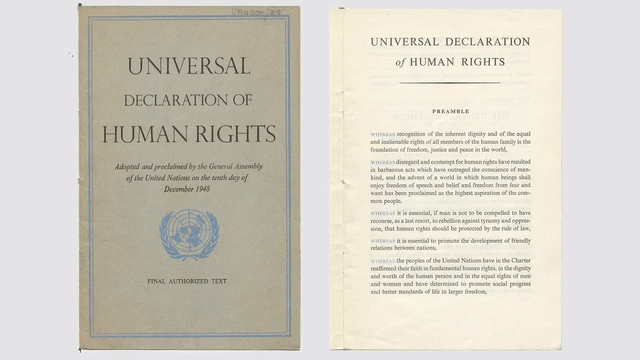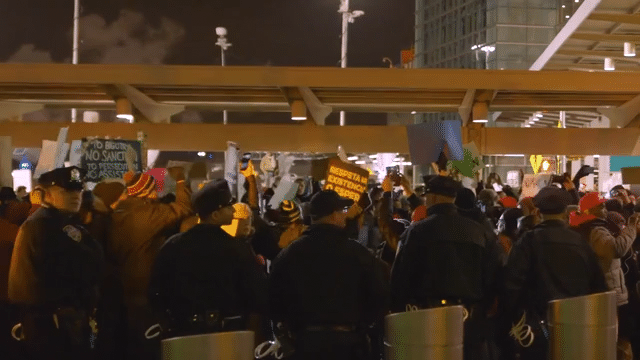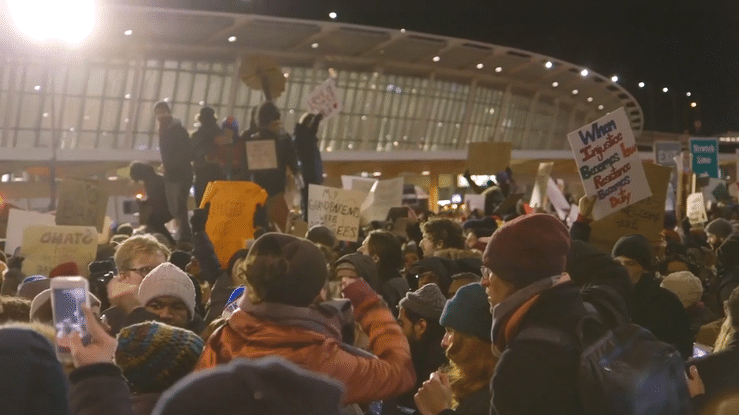How does the place where a person resides inform their legal claim upon the human right to dignity? How do images of brutality inflicted upon people affect the relationship between those people’s location and their ability to make rights claims? These are urgent questions to ask when war is no longer just something declared between nation-states, when mass media are devouring one conflict after another—from Syria to the US border and police violence against communities of color—and when the overwhelming speed and scale at which images of conflict circulate challenges our sense of personal, national, and ethical borders. These questions are prompted here by the Abounaddara film collective’s call for the “right to a dignified image,” a demand for a transnational civil protection to be modeled through the United Nations Universal Declaration of Human Rights.{1} Such a protection aims to extend equally to everyone the right to exercise control over how their image circulates.
The first step in linking these questions involves shifting away from the moral philosophy of how one ought to orient themselves to a rights politics that guarantees dignity, and toward a critical focus on the ways that images and the institutions that mobilize them do, or fail to, guarantee rights. In making this shift, one quickly arrives at the relationship between atrocity imagery and what Bonnie Honig describes as the “paradox of politics” that informs conventional human rights discourse.{2} Human rights politics are paradoxical for Honig because, while they appeal to a universal, and thus imaginary, community of humanity in which all people are thought to always already naturally belong, human rights imagery frequently attempts to call such a community into being through images of peoples whose injuries demonstrate their very exclusion from that imagined community. While the aspiration of human rights protections is informed by imaginary social bonds between individuals and groups, human rights imagery tends to traffic in images of bodily harm to particular bodies, as if rights can be made explicitly visual at the individual sites of their loss. Contemporary examples of such a paradoxical structure of representation abound: the 2019 photograph of the dead bodies of Óscar Alberto Martínez Ramírez and his daughter Valeria, face down on the bank of the Rio Grande River at the US border with Mexico; the 2015 video of a South Carolina police officer shooting Walter Scott in the back as Scott runs for his life; the iconic 2015 image of three-year old Alan Kurdi, whose lifeless body was photographed and circulated after washing ashore on a Turkish beach. In each of these cases, a widespread insistence that the subjects’ fundamental human rights were violated arrived only after their death, at the moment documentation of their deaths began to circulate.
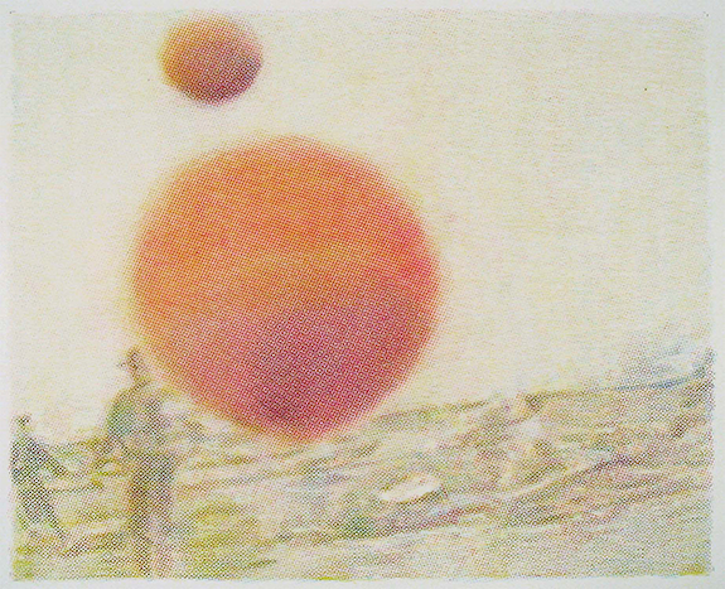 Figure 1. “Friendly Fire (a cameraman received minor injuries but continued to film with his
blood dripping on the lens)”, Stephen Andrews, 2003. Crayon on Parchment.
Figure 1. “Friendly Fire (a cameraman received minor injuries but continued to film with his
blood dripping on the lens)”, Stephen Andrews, 2003. Crayon on Parchment.
This paradox goes unnamed in Abounaddara’s 2015 call for the Right to the Image. Still, it underwrites the collective’s insistence that it is time to re-evaluate the role and value of atrocity imagery in wartime reporting, humanitarian campaigns, and human rights claims.{3} For the collective, the continued journalistic broadcast of images of atrocity from Syria has the capacity to further fuel the very conditions of violence that their circulation is often thought to help ameliorate. When images of suffering are circulated in the spirit of compassionate humanitarian concern, those images tend to invent or re-materialize the very “disenfranchised humanity that (they) claim to redeem.”{4} In doing so, documentary images have a way of solidifying rather than challenging the preexisting hierarchies that led to the atrocities documented in the first place. Dignity therefore begins for the collective as an ethical precept safeguarding Syrians from the circulation of images of bodily violation, but it also importantly extends beyond the question of representational ethics to how images of war in turn shape and reinforce the lived realities of those experiencing it.
One reason images of atrocity remain such a hallmark of human rights discourse may be accounted for by legal scholar Linda Bosniak’s notion of “ethical territorialism.”{5} Ethical territorialism, the dominant ethical framework through which liberal democratic states currently recognize or deny rights claims, insists that being here is the fundamental basis for extending rights and protections, whether that here is a function of physical location on a spatial grid, an embeddedness in a national project, or through the felt presence of human rights-driven visual media. In the absence of meaningful international enforcement frameworks, atrocity imagery, often deployed instrumentally, produces the feeling of physical presence. The feeling of presence then becomes the ethical basis for extending the recognition of rights to the injured. Viewed through this frame, the depiction of atrocity becomes integral, rather than incidental, to human rights media’s territorial appeal. By paying closer attention to some of the legal and aesthetic registers of human rights imagery, one can begin to imagine a world where human rights aren’t recognized in the image of distant suffering, but which can rather be collectively produced through images of shared power.
****
The Myth of Rights Possession
In 1951, as the philosopher Hannah Arendt continued to process the devastating aftermath of the Second World War, she wrote of the plight of those who had been ejected from the Western “trinity of state-people-territory” that “still form(s) the basis of European organization and political civilization.”{6} Human rights discourse gained urgency after the war with the recognition that those living without the civil and political rights granted to citizens of a nation-state should still be entitled to protections against the perceived abuses of repressive governments. As an aspirational form of governance, human rights discourse offered a framework for imagining power that accrues through a collective belief in the inherent dignity of all people. Human rights frameworks, so the narrative went, could enforce that belief in alliance with the political and military might of sovereign states when possible, or in opposition to them when necessary. Yet the United Nations, as one of the only supranational institutions able in theory to enforce rights claims across sovereign states, was in practice designed specifically to bring balance and stability to the hegemony of Western nation-states. It was never intended to oppose or supersede them.{7} The result is that well into the twenty-first century, rights claims and protections are still largely enforceable only through the sovereign body of the nation-state. To be sure, the past several decades have witnessed the significant growth of human rights norms and mechanisms. Nevertheless, what remains unreconciled is the tension between the concept of universal personhood on which many human rights frameworks are based and the legal and social conditions of territorial sovereignty that typically limit their force.
Arendt, who saw clearly the tension between the universalist aspirations of human rights discourse and the local and particular political conditions needed to make them enforceable, knew firsthand that meaningful rights protections are predicated upon belonging to a political community. Rights guarantees are chimerical unless they are coupled with collective political participation. Against the background of Arendt’s skeptical diagnosis, human rights advocates have championed the potentials of video and photography, when taken up by the oppressed, to offer a meaningful form of resistance to political excommunication. Henry Giroux, for example, suggests that if rightlessness is predicated upon political exclusion, then video can aid liberatory projects when it makes suffering visible across political borders. For him, video offers in this way agency and the possibility of inclusion for those without rights. But like Arendt, others have taken up a more critical position. Philosopher Giorgio Agamben has argued that wherever videos broadcast depictions of distant suffering, they only serve to reaffirm the very futility of rights discourse that Arendt highlighted.{8} Agamben resorts to the metaphor of the concentration camp to articulate his more fatalist view of media’s role in perpetuating, rather than alleviating, the plight of the already excluded.
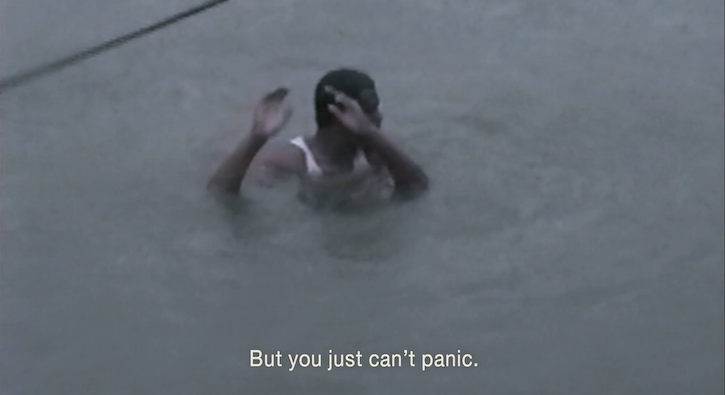 Figure 2. screen grab from TROUBLE THE WATER (2008). Henry Giroux, Pooja Rangan writes, “positions the exposure of black suffering as an urgent corrective to the racist collusion of the state and mainstream media apparatus.” In this context, Giroux celebrates the flood of
media documentations of Hurricane Katrina that challenged a media blackout on the effects of race and poverty.
Figure 2. screen grab from TROUBLE THE WATER (2008). Henry Giroux, Pooja Rangan writes, “positions the exposure of black suffering as an urgent corrective to the racist collusion of the state and mainstream media apparatus.” In this context, Giroux celebrates the flood of
media documentations of Hurricane Katrina that challenged a media blackout on the effects of race and poverty.
Without disputing Agamben’s and Giroux’s assertions that the recording and broadcast of shocking and shaming images to distant viewers have played a formative role in contemporary human rights discourse, it is time to look beyond the ethical axis of enfranchisement/disenfranchisement along which their writing aligns. For Giroux’s position is predicated on the political uses of images of suffering and Agamben’s position rehearses the trap of rights discourses within Western, capitalist nation-states, without offering meaningful ways to escape that trap. Until such a moment as the demise of the nation-state, we need to pay more attention to the structural and institutional logics of human rights within it. This age of migration sees nation-states of the Global North adhering to the normative position that rights are natural possessions of its citizens, fortified by an imagined homology between the geographic border and the reciprocal social relationships of a nation.
In order to introduce the concept of ethical territorialism and to explore the enduring links between ground, citizenship, and rights that animate her concept, Linda Bosniak turns to a mostly forgotten moment of political theater. In 2013, US Senator Rand Paul staged a thirteen-hour filibuster opposing the confirmation of John Brennan as the new director of the US Central Intelligence Agency.{9} At stake for Paul was the integrity of the Fifth Amendment, which guarantees American citizens the right to due process under federal law. Paul believed that the protection of due process was placed at risk by Brennan, who, as National Security Advisor, had overseen the 2011 drone assassination of US citizen Anwar al-Awlaki, a suspected terrorist living in Yemen. As Paul continued on the Senate floor, it became clear, however, that his sympathies did not lie with al-Awlaki, nor did he believe that al-Awlaki deserved protection under the Fifth Amendment. Rather, he demanded to know if the al-Awlaki operation provided a precedent for the government to kill citizens at home within the territorial boundaries of the United States. It was only to the latter prospect that the Kentucky Senator expressed horror.
Senator Rand Paul (R-KY) filibuster of the confirmation of John Brennan as CIA director, March, 2013. Courtesy of C-Span.
Paul’s filibuster offers a compelling moment to reflect upon how a person’s perceived location informs their ability to claim rights, a relation that is made increasingly complex by the deterritorializing effects of digital media and global migrations on our social and national imaginaries.{10} Paul’s line of thinking reflects the common tendency to more strongly identify with those who feel closest to us, whether in reality or in representation. As such, this case represents a normative example of ethical territorialism, a spatio-ethical framework that assumes that a person’s presence within the territory of a state—whether national or supranational—“should be the basis for extending them important rights and recognition.”{11} From the perspective of contemporary legal theory, it is the citizen of a state who is entitled to rights. Engaged in an obligatory network of reciprocal relations formed across shared territory, the citizens are the fundamental subjects of liberal democratic membership and recognition. In this account, citizenship is the fundamental subject position because it establishes “the right to have rights,” as Arendt provocatively wrote.{12}
But what about non-citizens? How might they be recognized? In response to this question, two answers most frequently arise.{13} The first answer embraces a status-based conception of rights. In this approach, persons are afforded rights protection through their recognized legal status. The second position endorses a territorial conception of rights based on location. It is the status argument that prevails under the 1948 Universal Declaration of Human Rights. But as Arendt noted in The Origins of Totalitarianism, the status argument’s claim for the right to have rights presents more problems than it solves.{14} For one thing, the right to have rights accorded by collective membership makes little sense outside of a community through which to secure those rights, and in the mid-twentieth century there were no supra-national communities of legal inclusion and enforcement outside of the nation-state. Thus, while human rights were designed to be a principle advantage of all citizens, “they risked becoming the last chance” of all those humans who did not enjoy the protection of the state.{15} Second, Arendt highlights the obvious tautology embedded in the phrasing “the right to have rights,” arguing that in this framing humanity has “in effect assumed the role formerly ascribed to nature or history.”{16} For Arendt, universal humanism can’t logically be defined as natural if nature itself has come to be understood through a vision of universal humanism. The fallacy of this position, as Arendt pointed out, is that it makes no distinction between a world populated by one person or one billion people. Human nature alone is not a sufficient framework for rights protection precisely because it is pre-political, because it imagines rights as inherently possessed rather than reciprocally guaranteed.
In contrast to the status definition, the territorial conception of rights turns to an individual’s geographical position inside the state as the basis for protection. Instead of focusing on assigned legal categories, it stresses “normative significance of presence.”{17} It emphasizes the physical and social fact of presence in a national space. In this case, being here is the right to have rights. Yet this too poses too many problems of boundaries and distance to provide a meaningful legal framework. Ethical territorialism stands for an ideal of universality within a territory. It is, however, typically either coupled with a vision of a bounded territorial community within which inclusion is to take place (thus rendering those who remain exterior to the boundary excluded), or, its universalist aspirations exceed its enforceability or the framework of a shared social identity that supports it. Bosniak calls this the “hard-outside/soft-inside” problem.{18} The imagined bond of shared soil that unites a nation is predicated on a set of boundaries and borders. Boundaries can always be extended in order to offer greater inclusion, but once everywhere becomes a territory of inclusion, the concept of the territory becomes stretched well past its utility.
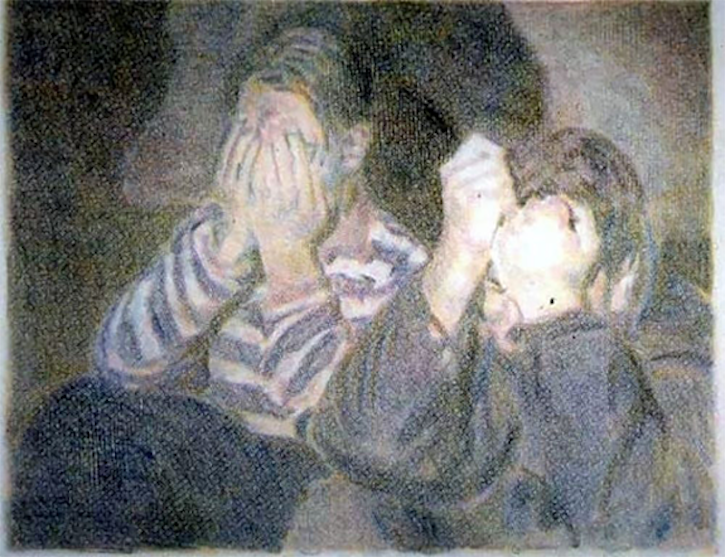 Figure 3. “At the Morgue,” Stephen Andrews, 2003. Crayon on Parchment.
Figure 3. “At the Morgue,” Stephen Andrews, 2003. Crayon on Parchment.
The merging of global humanitarian concern and audiovisual technologies that connect distant and dispersed peoples signals a spatial reconfiguration in practice that emerging human rights discourses had relied on in theory. In the long-standing absence of meaningful international treaty bodies to enforce global human rights abuses, monitoring duties have largely fallen “to journalists, filmmakers, and human rights organizations from international NGOs to local grass-roots social movements who use cameras to record abuses and appeal to action.”{19} Human rights media scholar Leshu Torchin sees such a formation as a crystallization of precisely the type of mediascape that informs anthropologist Arjun Appadurai’s influential demand for new post-national discourses that express the textures of translocal cultures.{20} For Appadurai, the political agency given to the concepts of culture, ethnicity, territory, and locality is neither natural nor inevitable, but stems from the primacy these concepts have been given in public discourse as narrative frames for contemporary culture.{21} Regardless of their origins, such concepts for Appadurai are no longer able to describe contemporary realities characterized by the deterritorializing forces of mass migration and new media technologies.{22}
The concept of ethical territorialism then complicates the relationship between the global circuits of human rights media and new discourses of post-national realities. As technological formations, infrastructures of media production and circulation well transcend the boundaries of particular states. Yet, as discursive formations that must respond to actually existing legal mechanisms, humanitarian media is nevertheless committed to reconciling the ethical tensions provoked by the perception of distance. To the extent that global systems of media circulation allow for a rehabilitation of ethical and legal concepts of society by extending the possibilities of civil inclusion, the ethical force of such systems remain to be reconciled against preexisting systems such as the nation-state.{23} Thus, humanitarian video of distant suffering does more to reproduce than to reconcile the failures of status-based and territorial conceptions of rights.
Arendt’s critique of rights foresaw this impasse, one that arises whenever rights are conceived as something that can be possessed. Emphasizing her point in the ninth chapter of Origins, she surprises some of her readers by agreeing with the conservative philosopher Edmund Burke that universal rights of man are nothing but “metaphysical abstractions.”{24} They were abstractions because their allusion to nature obscures the role that intentional acts of political membership play in enforcing rights claims. Burke would add that the Rights of Man were abstractions because they obscured the real source of modern authority, which was located in what he viewed as the unquestionable authority of the nation-state. However, where Arendt invited her readers to take seriously the active construction of new institutions that can enforce the rights of the stateless, Burke believed that the Rights of Man were to be dismissed altogether because they only echoed what the nation already naturally provided all of its citizens. For Arendt, rights are made, not had. For Burke, rights are always already had by those in the privileged position of full citizen. Arendt offered her readers no clear path to the alternative institutions and structures of safeguard that might transform new ethical imaginaries into legal realities. Meanwhile, Burke’s faith was well placed, because the sovereign nation still remains the dominant legal frame for guaranteeing rights, rendering human rights discourse largely redundant. The chasm remains between social realities, ethical imaginaries, and normative legal frameworks, one too frequently bridged by images of atrocity.
****
The Conventions of Atrocity Imagery
Contrary to decades of work by documentary and photography scholars who have challenged documentary’s immediate relationship to the real, conventional atrocity imagery still turns on the erasure of its own marks of mediation in order to produce what cinema scholar Pooja Rangan calls a “presentist politics of compassion.”{25} In the field of human rights and humanitarian media, Rangan and Leshu Torchin deconstruct the “assumption of self-evidence” that demands the ontological presence of the spectator in human rights witnessing.{26} Despite the complex discursive frameworks that surround their circulation and reception that these scholars trace, atrocity imagery frequently still relies on the logic of self-presence within the framework of ethical territorialism. This logic of presence suggests that images of violence restore and deliver witnesses anew to an unmediated flow of relations characterized by a “passion for the real,” the social over the systemic, semblance over resemblance, and the universal over the political.{27} As a practice reliant on the perception of proximity, atrocity imagery must overcome the double terrain of the photograph; that is, the spatial and temporal interval between the recording and exhibition of a historical event that figures so centrally in the ontology of photography. In my view, the authenticating forms of immediacy that mark atrocity photography’s perceived proximity to the real need to be reconciled with a similar tautological recourse to nature that informs the UN’s Universal Declaration of Human Rights. Like the UN declaration, conventional atrocity imagery relies on an exceptional logic that exceeds the medium-specific conditions in which it was recorded in order to be validated as a part of a shared territory so that it can then be judged as aberrant within the normative moral framework of that shared territory.
By exceptional, I mean that when images of violence circulate in order to shock viewers into some form of action, they tend to render the perception of the events that they document as anomalies and unfortunate exceptions, confirming rather than undermining the overall integrity of a universalist ethical imaginary. Such a logic of exception and excess is at work wherever atrocity photography is said to transcend the capacity of representational language, as in Susan Sontag’s account of her first encounter with images from Dachau that “cut me sharply, deeply, instantaneously.”{28} More recently, feminist performance scholar Peggy Phelan describes her encounter with Abu Ghraib photographs which, in her telling, resist coding and decoding and which expose an ideological blindness “that constitutes the very act of seeing.”{29} The logic of exception can also be located in the extra-discursive framing of atrocity photographs that seeks after the fact to reconcile the spatial disconnect that caused an atrocity in the first place. One example is the caption historian Studs Terkel gave to Nick Ut’s iconic 1972 photograph “Accidental Napalm Attack,” in which he surmised that “the kid in that plane that dropped the bomb probably didn’t see this little girl, did not know it hit her or destroyed the world in which she lived. This is what terrorism is all about. The impersonal aspect of it.”{30} Today, the atrocity image is more often produced by cameras built into weapons systems themselves, making it harder to position the camera as posterior and responsive to events. Lens-based images have become integral components in the routine operation of atrocity. They don’t capture unimaginable events which then shock us into action, so much as they have become constituent components in the routine operations of atrocity.
DIRTY WARS (Rick Rowley, USA, 2013).
This was the case in the drone missile assassination of Anwar al-Awlaki, in which the camera affixed to the drone simultaneously performed targeting and documentary functions. Nevertheless, the “kid in the plane” impulse re-emerges in Rick Rowley and Jeremy Scahill’s 2013 Dirty Wars, a film featuring a scene in which viewers look on with extended family members at home movie footage of a seven-year-old Abdulrahman Al-Awlaki, recorded in Colorado when the Al-Awlaki family still lived in the United States.{31} The boy was killed in Yemen in a separate drone attack two weeks after the campaign that targeted his father. An anonymous US official, seeking to offer a narrative framework to contextualize the government’s assassination of a seven-year-old US citizen, built on the if-we-only-knew trope when he remarked that “the US government did not know that (Abdulrahman) was there.”{32} In each of these cases, atrocity photography operates through a paradoxical logic. It exceeds the capacity of representation by negating its double in order to be validated as present, as a part of a shared world. Once it is acknowledged as part of a shared world, the events it contains are deemed an aberration, excessive, and apart from that very world it claims presence within. If ontological presence was perceived, each of these instances seem to suggest, the events the images contain would have turned out otherwise. The atrocities would not have taken place.
That imaginary of ontological presence is articulated differently in the 2015 online Al Jazeera America piece of reportage, “Charities Arrive in Calais to Help Refugees.”{33} The video begins with a pan across a dusty landscape where numerous migrants have taken up camp, accompanied by the voice of an off-camera journalist who asks his imagined audience, “What do you say about this?” It is a rhetorical question that both demands and precludes a response to the ethically fraught site of abjection being described by the camera. He continues to explain that what elevates the images of “Eritreans and Ethiopians” on screen to a newsworthy status is that the scene unfolds “not in Africa, but in Calais (France).” A representative for Solidarity International, one of a cluster of on-site NGOs, laments that it is “a failure to have to work on our own territory,” an effort that he notes the organization is forced to undertake for the first time in its thirty-five-year history. It is a curious statement, since the “Calais refugee crisis,” as Al Jazeera describes it, has in fact continued uninterrupted on French soil for two decades. The visual rhetoric, then, also forges political technologies of space and time to manage the sense of felt proximity to onscreen migrants, navigating a relationship that vacillates between a sense of invasiveness and stability. Its geographic proximity to home compels the on-screen anchor’s frustration. Yet, there is still a sense of shared possibility that marks that frustration, transforming defeatism into a plea for Western European empathy and response. Calais here threatens the ethical hierarchy that positions Western Europe and Western humanism as exterior to sites of abjection. Thus, the rhetorical positioning of crisis as emergency signals that the phenomenon is neither natural nor naturalized on European soil. If time is a key component to naturalization as the production of belonging, then crisis as temporal rupture compels an ethical obligation without shattering the imagined normative ethical framework that informs that obligation.
“Charities arrive in Calais to help refugees,” Originally broadcast on July 1, 2015. Courtesy of AL JAZEERA AMERICA.
A moment later, the report frames a close up of a medical worker applying ointment to a migrant’s gangrenous foot. The network’s visual emphasis on the gangrenous foot also reminds us, like “Accidental Napalm Attack” and the Abu Ghraib images, of the insistence upon positivism in atrocity media. Positivism, responding to the demand for visible evidence of human rights violations, reinforces a sense of ontological presence and epistemological certainty. Atrocity images in the humanitarian mode frequently rely on a positivist logic in which we can see horror in the image so that horror is confined to the image’s discursive field. Images that violate the perception of a shared ethical framework are thus able to produce surplus affect in order to engage the potentially disaffected without also producing surplus meaning. Positivism becomes a containment device in which “the borders of the frame” become the “bounds of the discussion.”{34} If atrocity were not self-evident in an image, it would require more and more supporting evidence to make its case. How long would it take, we might ask, before an expanding chain of evidence spills into life itself, transforming the exception that is depicted in positivist evidence into the ethical space of daily life?
This question animates critic Paul Arthur’s 2008 Artforum review of Errol Morris’s documentary Standard Operating Procedure (2008).{35} Morris’s film examines the infamous photographs from 2004 depicting the torture of Iraqi detainees by American soldiers at the Abu Ghraib prison during the US military’s invasion of Iraq. Arthur is perplexed by Morris’s focus on a revelation that the man who identified himself publicly as the hooded prisoner in a particularly iconic photograph proved not to be the actual victim depicted therein. Morris finds this fact compelling because he wishes to demonstrate that these atrocity images can “attract false beliefs.”{36} But Arthur rightly suspects that Morris’s focus on the figure in question blurs the larger picture. “Really,” Arthur asks? He continues, “I thought the images under consideration . . . reveal more about policy than about epistemology, more about state-sponsored barbarity than about media deception.”{37} Arthur’s exasperation reflects a desire to materialize a set of politics that he locates in the Abu Ghraib imagery, not visibly present but crystallized by the larger political forces that the photograph condenses. He longs for a politics that can’t be kept at a distance nor confined to the edges of the image. Morris doesn’t argue for fewer photographs. Rather, he wants more images with more solid “chains of custody,” epistemological operations that ensure the temporal, spatial, and descriptive registers of the image from recording to reception.{38} But we don’t need more images. What is needed, of course, is less state-sanctioned torture. Insofar as an aesthetics of positivism proposes to offer a solution to the decontextualizing technological effects of modernity, it is one more political technology that is seldom recognized as such. As a conceptual approach to articulating presence, it operates in tandem with other concepts of belonging such as native/invasive, nature/naturalization, and ethical territorialism.
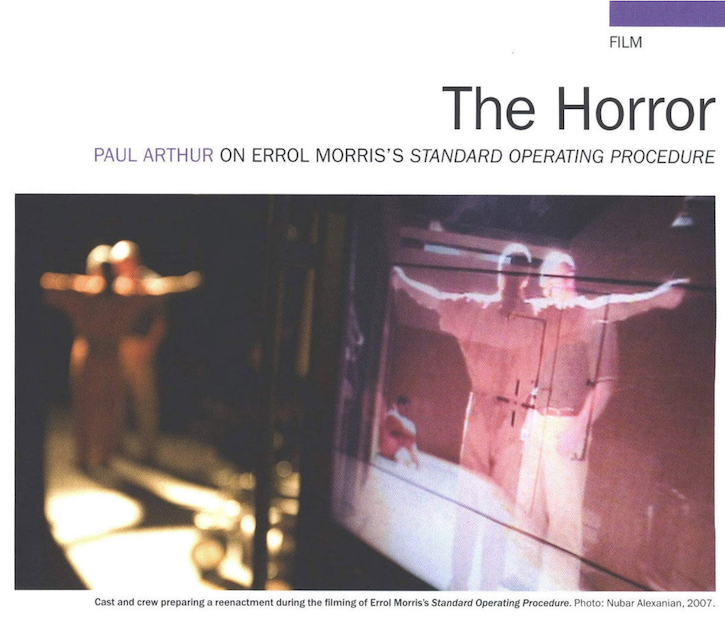 Figure 4. ARTFORUM 46:8, (2008), p. 112.
Figure 4. ARTFORUM 46:8, (2008), p. 112.
****
Updating the Status of Rights
“The calamity of the rightless,” in Arendt’s phrasing, plays out over and again wherever human rights discourse relies upon images of suffering to summon concern from distant viewers.{39} One strategy for interrupting this loop is to picture rights not as possessions to be had or have lost, but rather as actions to be won and maintained. At a moment when social media platforms have dramatically increased many viewers’ exposure to human rights appeals from across the globe, it is fitting to make this distinction through two uses of the term status.
One way to characterize nondemocratic systems of governance is that their constitutions do little more than enshrine the status of those who have already been historically vested with authority and power over a society. For Arendt, this is precisely the failure of the United Nations’ Universal Declaration of Human Rights: it secures the status of those who already have rights while the image of suffering demonstrates the inescapable reality of the sufferer who lacks status. Democratically constituted societies, on the other hand, involve frameworks for transforming the historically powerless from the subjects to the agents of political power. But status cannot simply be given, constitutionally or otherwise. It has to be maintained and continually renewed. Status must constantly be updated through collective actions that work toward a world in which everyone can legitimately claim the right to dignity in legally and culturally mediated forms of representation.
This more dynamic approach to status invites recognition that alternative forms of image cultures that do human rights work already exist, even if they are seldom recognized as such. One example might come by way of the January 2017 protests at international airports that came in reaction to the new US president’s ban on immigrants from predominantly Muslim-identifying countries. Tens of thousands of protestors across the United States swiftly responded to an impromptu call made by organizers via social media platforms to occupy dozens of airport terminals where the administration’s xenophobic policies were taking effect. Thousands of photos and videos shared by protestors, registering their participation in this collective action, testify to its power and potential, but also its real limits. Power, because it was a moment in which rights claims were pictured not at the site of their loss but at the sites where they could be collectively enforced, and because the performativity of the demand for maintaining rights recognition to non-citizens of color was not merely performative. The demand was accompanied by the force of thousands of bodies in airport terminals. It was limited in its effect because to be successful in the long term, the performative dimension of the protests must be recognized by a sustaining external power.
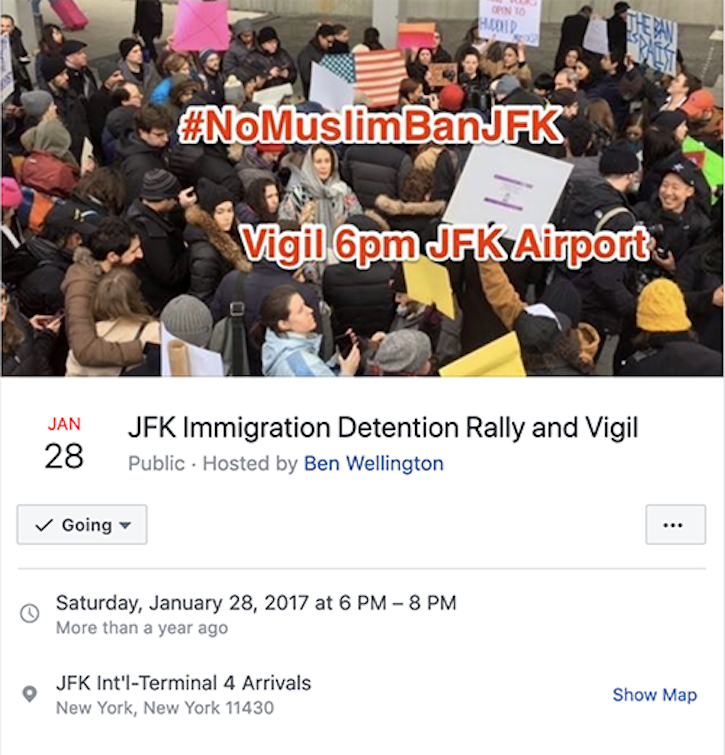 Figure 6. Facebook event invite for #NoMuslimBanJFK protest. Within hours of the Facebook post, thousands of people had assembled at
Terminal 4 of JFK International Airport in New York City.
Figure 6. Facebook event invite for #NoMuslimBanJFK protest. Within hours of the Facebook post, thousands of people had assembled at
Terminal 4 of JFK International Airport in New York City.
Another example might be found in the hundreds of videos circulated online by Abounaddara itself, the film collective that emerged with the onset of the Syrian uprising, and one whose prodigious output between 2011 and 2017 formed a counter-archive to popular documentary and broadcast journalism depictions of the war. The collective’s goal has not been to memorialize the past nor to render the immediacy of the Syrian present, but to create forward-looking images of a potential Syrian future characterized by the collective strength of a diverse population. And this strength, the collective argues, is buttressed by the external force of viewing publics across the globe whenever they refuse to participate in the uptake of images of violence broadcast by human rights and journalistic outlets alike. Thus, while their hundreds of videos are much too diverse in form and content to characterize, what links them all is their refusal to show images of bodily harm, their lack of attribution to single authors, and their absence of geographic and identitarian specificity. These gestures, for the collective, challenge the link between territory and belonging by subduing the contextual information that might inform viewers’ senses of ethical and physical distance. “Images of war are images that wage war,” Abounaddara argues, when the abjection frequently contained in war reportage reaffirms the violent power of the regime that Syrian revolutionaries sought to overthrow.{40} Images of atrocity wage war too when they are reduced to their evidentiary uses, and when they uphold instead of challenge legally defined borders of political belonging.
With these two brief examples, I intend neither to create an equivalence between them nor to valorize the makers responsible for them. Rather, I reference them to highlight the contingent role that images can play in catalyzing or maintaining particular forms of political organization and recognition in relation to political crisis. Arendt warned readers against recognizing equality though sameness, through images of dispossession and abjection as signs of undifferentiated suffering, or through guarantees that precede one’s encounter with the difference of others. Through very different aesthetic modes and in different political contexts, these brief examples each confront the dominance that ethical territorialism still holds in the imagination of Western nation-states. At stake in these emerging forms of image cultures are gestures towards more meaningful, if fragile and contingent, conceptions of rights, what it means to have them, the role of images in animating them, and the empowerment of people, inside as well as outside the boundaries of the photographic frame, in securing them.
An earlier version of this essay was commissioned by the Vera List Center for Art and Politics at The New School to critically examine the work of Abounaddara, recipient of the 2014-2016 Vera List Center Prize for Art and Politics.
Background Video: Universal Declaration of Human Rights, Final authorized text (1946) / America Is My Home – Day #8 of the Trump Administration (Meerkat Media Collective, US, 2017).
{1} The Abounadddara Collective, “A Right to the Image for All: A Concept Paper For A Coming Revolution,” Vera List Center.
{2} Bonnie Honig, “Three Models of Emergency Politics,” Boundary 2 41, no. 2 (2014): 46.
{3} Ibid.
{4} Pooja Rangan, Immediations: The Humanitarian Impulse in Documentary (Durham: Duke University Press, 2017), 1.
{5} Linda Bosniak, “Soil and Citizenship,” Fordham Law Review 82, no. 5 (2014): 2069–75.
{6} Hannah Arendt, The Origins of Totalitarianism, second ed. (New York: Meridian, 1968), 282.
{7} See Samuel Moyn, The Last Utopia: Human Rights in History (Cambridge: Harvard University Press, 2010).
{8} See Giorgio Agamben, The Open: Man and Animal, trans. Kevin Attel (Stanford, CA: Stanford University Press, 2004).
{9} Bosniak, “Soil and Citizenship.”
{10} This is not to diminish the extent to which ethnicity and al-Awlaki’s Muslim identity facilitates the ease with which Paul renders al-Awlaki exterior to the United States. Rather, it further highlights the ways that ethnicity arises when the perceived link between culture and territory is broken.
{11} Linda Bosniak, “Ethical Territoriality and the Rights of Immigrants,” Amsterdam Law Forum 1, No. 1 (2008).
{12} Arendt, Origins, 296.
{13} Ibid.
{14} Arendt, Origins, 290-302.
{15} Moyn, The Last Utopia, 12.
{16} Arendt, Origins, 298.
{17} Bosniak, “Soil and Citizenship”: 2071.
{18} Linda Bosniak, “Being Here: Ethical Territoriality and the Rights of Migrants,” Theoretical Inquiries in Law 8 (2007): 389.
{19} Leshu Torchin, Creating the Witness: Documenting Genocide on Film, Video, and the Internet (Minneapolis: University of Minnesota Press, 2012), 4.
{20} Torchin, Creating the Witness, 12.
{21} Arjun Appadurai, Modernity at Large: Cultural Dimensions of Globalization (Minneapolis: University of Minnesota Press, 1996).
{22} Appadurai’s argument also reverberates in Abounaddara’s position that they will not participate in any exhibitions that contextualize their work through a primarily geographic frame.
{23} As a visual practice of representing non-white and/or non-Western peoples, this position does not operate in contradiction to the writings of Trinh T. Minh-ha and others whose vital work reveals the othering capacities of Western practices of cultural representation. Rather, it argues that the logic of human rights media operates through Michel Foucault’s notion of biopower, as a process of inclusion, as much as it does by exclusion.
{24} Edmund Burke, Reflections on the Revolution in France, ed. Frank M. Turner (New Haven: Yale University Press, 2003).
{25} Rangan, Immediations, 1.
{26} Torchin, Creating the Witness, 145.
{27} Alain Badiou, The Century (Cambridge: Polity Press, 2007), 55.
{28} Ibid.
{29} Peggy Phelan, “Atrocity and Action: The Performative Force of the Abu Ghraib Photographs,” in Picturing Atrocity: Photography in Crisis, eds. Geoffrey Batchen, Mick Gidley, Nancy K. Miller and Jay Prosser (London: Reaktion Books, 2014), 55.
{30} Studs Terkel in Time: Great Images of the 20th Century (New York: Time Books, 1999).
{31} Dirty Wars. Dir. Richard Rowley. 2013.
{32} “U.S. airstrike that killed American teen in Yemen raises legal, ethical questions,” Washington Post, October 23, 2013.
{33} See Al Jazeera America, “Charities Arrive In Calais to Help Refugees,” July 1, 2015.
{34} Ariella Azoulay, “The Execution Portrait” in Picturing Atrocity: Reading Photographs in Crisis, eds. Geoffrey Batchen, Mick Gidley, Nancy K. Miller, and Jay Prosser (London: Reaktion Books, 2012), 251.
{35} Paul Arthur, “The Horror: Paul Arthur on Errol Morris’s Standard Operating Procedure,” Artforum 46, no. 8 (2008): 111.
{36} Errol Morris, Errol Morris: Believing Is Seeing (Observations on the Mysteries of Photography) (New York: Penguin Press, 2011): 92.
{37} Ibid.
{38} Torchin, Witness, 154.
{39} Arendt, Origins, 135.
{40} Abounaddara Collective, paraphrasing Serge Daney in Jason Fox and the Abounaddara Film Collective, “Representational Regimes,” World Records 1. See Serge Daney, “Before and After the Image,” trans. Melissa McMahon, Discourse 21, no. 1 (1999): 181–190.


